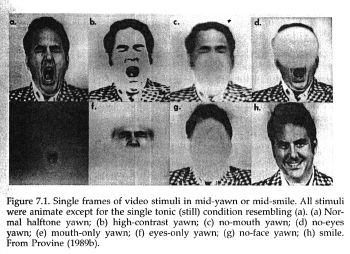Yawning is a remarkable behavior that
is overlooked only because it is so commonplace.
Consider the phenomenon of contagiousness. You
yawn or are tempted to yawn when you observe
someone else yawning. You are not tempted to
yawn by a desire to imitate the yawner. The
observed yawn triggers an inborn visual
recognition process in our brain that is
programmed to detect yawns. When the yawn
detector is activated, it triggers the
stereotyped act of yawning.
Observed yawns produce a chain reaction of
yawning that synchronizes the behavior and
probably the physiological state of the group.
The analysis of such contagious yawning provides
insights into a very ancient and previously
ignored class of neurologically mediated social
behavior. Contagious yawning also provides a
useful, although unlikely, tool to investigate
the more general problems of neural and computer
pattern recognition.
Because visually observed yawns trigger
yawns, contgious yawning can be used to assay
the activation of the neurological yawn
detector. In other words, contagious yawning can
teach us about the underlying logic of visual
pattern detection. Using this approach, our
laboratory has been able to specify the features
of the animate yawning face necessary to evoke
contagious yawning.
In our first approach to this problem, a
videotape of a yawning face was edited so that
various facial features such as the mouth could
be presehted in isolation, or a feature such as
the mouth could be deleted from an otherwise
intact face. The rather surprising result was
that the video image of the gaping mouth, one of
the most obvious features of a yawning face,
stimulated few yawns. In fact, a yawning mouth
presented out of the context of the yawning face
was an ambiguous stimulus. The isolated mouth
could be that of someone yelling or singing.
This result complemented the finding that a
videotaped yawning face lacking a mouth was as
effective a yawn-evoking stimulus as an intact
yawning face.
A series of such analyses indicated that the
neurological "yawn- detector" was activated by
the overall configuration of the yawning face,
not by a single feature such as the mouth. This
result complicated the analysis. The invariance
in the visual stimulus that is the unique
signature of the yawn must involve a specific,
time-ordered change of a constellation of
features. Computerized line cartoon simulations
of yawns offer a complementary, more
reductionistic tactic for identifying the
stimulus configuration that activates the
brain's yawn detector. In contrast to the
relative wealth of visual complexity and
redundancy of the videotaped images, the cartoon
representation of yawns relies upon the most
skeletal element of visual form, the line. Line
cartoons of any type, including smiling faces
and stick men, are recognizable representations
of reality because they are attuned to the
brain's neurological shorthand for visual
features. There is a lot of psychology and
neurology in cartoons.
The use of computer-generated visual displays
allows the experimenter to specify the yawning
stimulus in both space and time. (High-quality
speedups and slowdowns of animation sequences
are difficult to accomplish with videotape
technology.) The first step in producing
realistic line cartoon animations of yawning
involves knowing what to animate and then
producing a high-quality visual display of the
data. A low-quafity display that evokes no yawns
of observers would produce an indecisive result;
we would not know if some essential element of
the yawn were omitted, a potentially interesting
result, or if the display was simply toc, crude
to be effective.
A microanalysis of the normal yawning face
produced the graphic data base necessary for the
simulations. This rather labor- intensive
exercise (two student summers in duration)
involved the measurement of thousands of
individual frames f rom video-taped records of
48 yawns produced by 12 subjects. Special
attention was given to the shape and area of the
mouth and eyes, and their relation to the
overall configuration-of the yawning face.
Preliminary line animations from these data
have been produced with an antiquated Apple Il
computer. We have just started examining the
relative yawn-evoking potency of yiwns differing
in duration, mouth shape, change in mouth area
over time, and degree and timing of eye squint.
However, further analyses must await the
acquisition of a fast, powerful graphics
computer.
I regret leaving you with an account of an
experimental journey that has just begun, but
the logic of the approach may be informative,
even for those with no interest in yawning.
Bigger issues are at stake. At the very least,
the present analysis should tell us something
about preprogrammed visual recognition
mechanisms in our brains. The identification of
a mechanism for yawning establishes a precedent
for what may be a general class of neural visual
feature detectors. Yawning research may also
provide insights into the difficult applied
problems of how to produce, store, sort,
transmit, and recognize biologically relevant
visual images of people and objects. The present
tale about yawning teaches us that there is an
inherent relation between the biological,
psychological, and synthetic domains.




